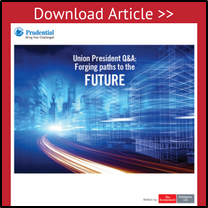Unions are facing mounting pressures at a time when anti-union legislation is undermining collective bargaining efforts, and workers are struggling with economic and technological shifts. How can unions strengthen worker advocacy and persevere in the future?
The Economist Intelligence Unit discussed these issues with Lee Saunders, President of the American Federation of State, County and Municipal Employees (AFSCME), and Christopher Shelton, President of the Communications Workers of America (CWA).
How can unions engage non-union members or collaborate with other labor organisations to build a collective voice?
CHRISTOPHER SHELTON: CWA has been involved in forming alliances with organisations outside labour for quite a long time. We realised that we had to get bigger than just unions. We had to go outside and form alliances with environmental organisations, churches and faith groups, you name it.
We have alliances in lots of places with organisations outside the labour movement. And we’ve used technology to help us do that. For instance, if you look at the Women’s March in January 2017, without technology, that just would not have happened. We also use technology to form alliances with other organisations like the NAACP. These alliances have benefited us. Together we develop rallies, marches and actions to try to bring about change in this country.
LEE SAUNDERS: We’re developing relationships within the labour movement and outside the labour movement to deal with the attacks on workers’ rights across the country. But these efforts go more toward developing and identifying a commonality of interests, not only on workers’ issues, but also on issues that affect the communities in which our members live, and then developing the kind of mechanism where we’re able to fight back.
And I think that you see that happening in state after state after state. If you look at the last elections in November, for example, people got together and formed these alliances and coalitions, and referendums to increase the minimum wage. We were overwhelmingly successful, because we were able to garner the strength and the power, not only of union members, but of people who believe that wages should rise, and that there should be a higher minimum wage.
What can be done to ensure that American workers have future work opportunities?
CHRISTOPHER SHELTON: Workers in the future will have a big problem trying to get new jobs because they don’t have the training. There are very few training programs that exist to try to train people on new technology. However, a lot of unions have apprenticeship programs, for instance, to train people to go from Job A to Job B or to get to Job B in the first place. CWA, for example, has lots of training programs that we offer to our members to prepare them for jobs that are focused on the future.
Our politicians and our new administration should also be looking at this issue, to try to figure out ways to train people to do jobs that they can’t do now. Workers have to be educated, but education costs so much money. We have to figure out a way so that kids can go to school today to learn the jobs of the future, to learn what they have to learn to compete in the world and not graduate with the crushing debt that they have today.
LEE SAUNDERS: Unions can play a major role in providing education to our members and their family members. A number of unions have made necessary adjustments, setting up training academies, and setting up schools for members. AFSCME, for example, has developed a program where we offer our members and their families a free two-year educational program in a community college, with the ability to transfer those credits to a four-year school. These efforts do not take the place of collective bargaining, which we believe is the foundation for improving the lives of working people. But we also need to take an expanded role in identifying the kinds of things that we must do to understand the changing economy, and to develop the necessary tools with workers, so they can make those adjustments at the new jobs.
How can unions get younger workers more involved in labour organising?
LEE SAUNDERS: Young workers have got to understand that the wages and benefits that have been negotiated in unionised settings did not happen magically. AFSCME has developed a program called the Next Wave program, to better engage our younger members aged 35 years and under. Sooner or later, these Next Wavers are going to be in leadership positions, they’re going to be working for the union, maybe even holding an elective office, and we’ve got to listen to what they’re thinking. And the way that they think is completely different than the way that I thought when I was a Next Waver a little while ago.
For example, we have local union meetings once a month, and a lot of people can’t attend those meetings. So the Next Wavers will say, why do we have to have those kinds of meetings? We’ve got the new technology available to us where we don’t have to attend the meetings, but we can participate. So we developed new technology that can encourage more people to participate in the affairs of the local unions, without expecting them to have to come to a meeting every month. The Next Wavers have brought some very basic kinds of concepts and ideas that we’re trying to emulate across the country.
CHRISTOPHER SHELTON: Millennials can teach us an awful lot because they are the union members of the future. We have something called the Next Generation Committee within CWA, for example, that we use for not only advice but to get millennials involved in our union. It works fantastically and we learn as much as they learn.
Our Next Gen Committee are all members of CWA who are under 35 years old. Older CWA members act as mentors at the Next Gen Committee’s request. We’ve seen that the millennials and those under 35 want to talk to people who have been around a little while longer because it gives them insight into what the world is really like.







